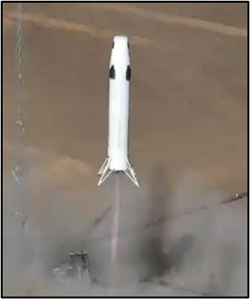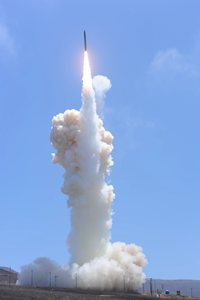[Editor’s Note: As observed in the Transparent Battlefield section of the TRADOC G-2’s The Operational Environment 2024-2034: Large-Scale Combat Operations:
“The modern battlefield is growing progressively more transparent because of the proliferation of advanced technologies—smart devices, sensors, emitters, etc.—as well as the emergence of hyperconnected global communications and social media.“
China continues to observe and learn strategic, operational, and tactical lessons from Russia’s “Special Military Operation” in Ukraine. It understands the Command and Control (C2) resiliency a constellation of communications satellites like Starlink could provide the People’s Liberation Army (PLA). Such a constellation, however, requires a robust orbital launch capability — as reported in the Wall Street Journal per China’s State Media, “the country will launch more than 20,000 satellites over the next decade to build out satellite broadband capabilities.”
Today’s guest post by Nathan (Luke) Roth explores how China plans to achieve its ‘Thousand Sails Constellation’ of telecommunications satellites through the convergence of commercial launch providers, Liquid Oxygen (LOX) reusable rockets, 3D printing, and machine learning-based intelligent fault diagnosis algorithms — revolutionizing China’s access to Low, Medium, and Geostationary Earth Orbit (LEO, MEO, and GEO). Luke also addresses the associated implications for the U.S. Army and the broader economic and Space Domain ramifications. This isn’t your granddad’s space race — Read on!]
Interstellar Glory Space (i-SPACE) Technology and Land-Space are Chinese commercial aerospace firms that have recently integrated many advanced technologies into designing and developing Liquid Oxygen (LOX) reusable rockets. They have incorporated several advanced technologies, including reusable rocket boosters, 3D printing, advanced avionics, intelligent fault diagnosis, and propulsion technologies. Integrating these innovative technologies has allowed the Chinese aerospace industry to develop a more cost-effective and reliable LOX rocket, which can potentially meet the growing demand for satellite launches in China for their government and commercial sectors in the coming years. Once fully matured, this technology has the potential to support the People’s Liberation Army (PLA) in the Space Domain and may pose heightened security threats to the U.S. and its military.1

Developed by i-SPACE, the Hyperbola-1 is designed as a reusable rocket booster devised for the LOX Jiao Dian rocket, enabling the system to return to the launch site after delivering its payload into orbit, similar to the Falcon 9 booster developed by SpaceX. The Hyperbola-1 uses kerosene and LOX as propellants. The booster uses a combination of parachutes and retro-rocket propulsion to slow its descent and land vertically. This allows Hyperbola-1 to achieve a higher thrust-to-weight ratio and better performance than most other engines in its class. However, the i-SPACE’s reusable rocket booster is still in the development and testing phase.2

Developed by Land-Space, the Zhuque-3 rocket is a second example of a Chinese test rocket model making significant steps toward the country’s goal of achieving reusable launch capabilities. The rocket is designed to have a reusable first stage, which can land back on Earth after launch and be refueled for subsequent missions. It is powered by methane-liquid oxygen (methalox) engines, which are known for their high efficiency and low emissions and has a large payload capacity, allowing it to launch various satellites and spacecraft into orbit. According to media reporting from early September 2024, the Chinese conducted a successful 10-kilometer vertical liftoff and landing test, with an orbital flight planned in 2025.3
I-SPACE and Land-Space use 3D printing technology to design and manufacture their launch vehicles. I-SPACE uses 3D printing to produce components for its Hyperbola-1 rocket booster, including the main engine combustion chamber and nozzle. 3D printing allows the company to create complex geometries and shapes that would be difficult or impossible to produce using traditional manufacturing methods. This results in lighter, more efficient, and more cost-effective components. Additionally, 3D printing allows for rapid prototyping and iterative design, which can be beneficial in developing new technologies.4
I-SPACE and Land-Space deploy advanced avionics systems to design and develop their rocket launch systems. These capabilities include advanced guidance, navigation, and control systems that allow the rockets to deliver payloads accurately into orbit. Both companies use advanced telemetry systems to monitor their respective rockets’ performance during flight and make necessary adjustments to ensure a successful mission.5
Both companies have developed a cutting-edge intelligent fault diagnosis capability for the rocket vehicle frames. Intelligence fault diagnosis is beneficial in space systems, where the complexity and cost of the systems make traditional fault diagnosis techniques difficult or impractical. By using machine learning algorithms to analyze data from sensors or other sources, intelligence fault diagnosis can identify patterns or anomalies that may indicate a fault, which could be missed using traditional fault diagnosis techniques.6
I-SPACE developed advanced propulsion technologies in the design and development of its launch vehicles. The engine has a sea-level thrust of 85 tons, a vacuum thrust of 105 tons, a thrust adjustment range of 35% to 110%, and a thrust-to-mass ratio greater than 100. It is also worth noting that it is the largest thrust LOX rocket engine and has reportedly completed test runs in China.7
China has been actively expanding its space program and has ambitious plans for hundreds of satellite launches in the next few years. Aiming for around 100 launches in a single year is a significant step towards its goal of becoming a leading space power. These launches will likely support various applications, including communications, remote sensing, intelligence, navigation, and scientific research.8 China’s space advancement may challenge international corporations for market share in the space industry, such as satellite-provided internet services.9
 Developing the reusable rocket technology is critical for China’s ‘Thousand Sails Constellation’ ambition. The Thousand Sails Constellation plan is a Chinese initiative to provide global broadband internet coverage. It is part of China’s ambition to become a leading space power. The constellation aims to provide high-speed internet access to all parts of the world, including remote and underserved areas in the Global South. The constellation will support various commercial applications, such as telecommunications, remote sensing, and navigation. However, this dual-use capability will also support national security, providing encrypted military communications and surveillance capabilities for China. Similar to SpaceX’s Starlink project, this Chinese initiative will provide global internet coverage using a large constellation of low earth orbit (LEO) satellites.10
Developing the reusable rocket technology is critical for China’s ‘Thousand Sails Constellation’ ambition. The Thousand Sails Constellation plan is a Chinese initiative to provide global broadband internet coverage. It is part of China’s ambition to become a leading space power. The constellation aims to provide high-speed internet access to all parts of the world, including remote and underserved areas in the Global South. The constellation will support various commercial applications, such as telecommunications, remote sensing, and navigation. However, this dual-use capability will also support national security, providing encrypted military communications and surveillance capabilities for China. Similar to SpaceX’s Starlink project, this Chinese initiative will provide global internet coverage using a large constellation of low earth orbit (LEO) satellites.10
Implications for the U.S. Army

LOX reusable rockets can be used for military purposes, such as launching satellites or ballistic missiles. From a military perspective, China’s development of LOX rockets could have implications for the U.S. Army’s ability to defend against potential threats from space, resulting in increased national security concerns. LOX rockets are known for their high performance and efficiency, which could allow the PLA to launch more missiles with longer ranges. LOX rockets are designed to be highly maneuverable, which could give the PLA an advantage in evading missile defense systems. This could potentially make it more difficult for the U.S. and other countries to defend against PLA Rocket Force (PLARF) missile attacks. Using LOX rockets could also allow the PLA to launch heavier payloads more efficiently, such as nuclear warheads or multiple independently targetable reentry vehicles (MIRVs). Using LOX rockets could also enable the PLA to develop space-based missile defense systems, potentially giving China an advantage in defending against missile attacks.
China’s development of LOX reusable rockets could be considered part of the ongoing space race with the US. This could have implications for the US’s ability to maintain its leadership in space technology. This competition has taken many forms, including the development of advanced launch vehicles and the deployment of satellites to support military and national security capabilities, such as the Chinese Beidou satellite navigation system  (the Chinese equivalent of the US-owned GPS), which currently consists of a constellation of 35 operational satellites in medium Earth orbit (MEO) and geostationary Earth orbit (GEO). Using LOX rockets could enable China to launch larger and more complex spacecraft, which could affect the US’s ability to maintain its leadership advantage in space.
(the Chinese equivalent of the US-owned GPS), which currently consists of a constellation of 35 operational satellites in medium Earth orbit (MEO) and geostationary Earth orbit (GEO). Using LOX rockets could enable China to launch larger and more complex spacecraft, which could affect the US’s ability to maintain its leadership advantage in space.
Potential economic risks to SpaceX, their subsidiary Starlink, and the broader US Space Industry. The global market for satellite internet services is growing rapidly, offering significant opportunities for the Thousand Sails Constellation. If the Thousand Sails Constellation is successful in gaining a considerable market share, it could disrupt the market dynamics and challenge Starlink’s dominance internationally. This could have broader implications for the U.S. space industry, as SpaceX and Starlink play significant roles in driving innovation for the US.
If you enjoyed this post, check out the TRADOC G-2’s new OE Assessment — The Operational Environment 2024-2034: Large-Scale Combat Operations
Explore the TRADOC G-2‘s Operational Environment Enterprise web page, brimming with information on the OE and how our adversaries fight, including:
Our China Landing Zone, full of information regarding our pacing challenge, including ATP 7-100.3, Chinese Tactics, BiteSize China weekly topics, People’s Liberation Army Ground Forces Quick Reference Guide, and our thirty-plus snapshots captured to date addressing what China is learning about the Operational Environment from Russia’s war against Ukraine (note that a DoD Common Access Card [CAC] is required to access this last link).
Our Russia Landing Zone, including the BiteSize Russia weekly topics. If you have a CAC, you’ll be especially interested in reviewing our weekly RUS-UKR Conflict Running Estimates and associated Narratives, capturing what we learned about the contemporary Russian way of war in Ukraine over the past two years and the ramifications for U.S. Army modernization across DOTMLPF-P.
Our Running Estimates SharePoint site (also requires a CAC to access), containing our monthly OE Running Estimates, associated Narratives, and the 2QFY24, 3QFY24, and 4QFY24 OE Assessment TRADOC Intelligence Posts (TIPs).
Check out the following related Mad Scientist Laboratory content:
War Laid Bare, by Matthew Ader
African Skies: Space Exploration and National Security Perspectives and associated podcast, with Selina Hayes,
Building Beyond: Preparing the Army for Lift-Off and associated podcast, with Dr. Olga Bannova
LSCO, PNT, and the Space Domain, by CPT Matthew R. Bigelow
Space: Challenges and Opportunities
Star Wars 2050, The Final Frontier: Directed Energy Applications in Outer Space, and The Evolution of Nation-States and Their Role in the Future, by proclaimed Mad Scientist Marie Murphy
Beyond Space and associated podcast, with proclaimed Mad Scientist Kara Cunzeman
Space 2035: A Surplus of Uncertainty and a Deficit of Trust, by Maj Rachel Reynolds
Accelerating American Space Settlements, by Dr. Lydia Kostopoulos
… as well as the Dr. Moriba Jah on What Does the Future Hold for the US Military in Space? podcast hosted by our colleagues at Modern War Institute.
About the Author: Luke served in the Army as an all-source analyst from 2000-2007 and has held many analyst roles ranging from all-source to simulations as a contractor from 2007 to present.
Disclaimer: The views expressed in this blog post do not necessarily reflect those of the U.S. Department of Defense, Department of the Army, Army Futures Command (AFC), or Training and Doctrine Command (TRADOC).
Notes
1 OSINT Center of Excellence, “China Science and Technology Semi-Monthly Research Update.” PiX Dababase, (15 November 2023). Asian Studies Detachment (ASD) | PiX (pixtoday.net)
2 Jones, Andrew, “China’s I-SPACE Launches and Lands Rocket Test Stage.” Space News, (02 November 2023). China’s iSpace launches and lands rocket test stage – SpaceNews
3 Rising Nepal Daily, “China’s Commercial Reusable Test Rocket Completes Vertical Takeoff, Landing Flight Test.” (11 September 2024). China’s commercial reusable test rocket completes vertical takeoff, landing flight test (risingnepaldaily.com)
4 The Hong Kong Polytechnic University (PolyU), “3D Printing in Space and Why it Matters on Earth.” Hong Kong Polytechnic University, (01 August 2024). https://libguides.lb.polyu.edu.hk/i-Space/3d_printer & Rising Nepal Daily, “China’s Commercial Reusable Test Rocket Completes Vertical Takeoff, Landing Flight Test.” (11 September 2024). China’s commercial reusable test rocket completes vertical takeoff, landing flight test (risingnepaldaily.com)
5 OSINT Center of Excellence, “China Science and Technology Semi-Monthly Research Update.” PiX Dababase, (15 November 2023). Asian Studies Detachment (ASD) | PiX (pixtoday.net)
6 Pandaily, “I-SPACE JD-2 Engine Successfully Completes its 1st Full-system Test Run.” (27 September 2023). i-Space JD-2 Engine Successfully Completes Its 1st Full-system Test Run – Pandaily & Rising Nepal Daily, “China’s Commercial Reusable Test Rocket Completes Vertical Takeoff, Landing Flight Test.” (11 September 2024). China’s commercial reusable test rocket completes vertical takeoff, landing flight test (risingnepaldaily.com)
7 OSINT Center of Excellence, “China Science and Technology Semi-Monthly Research Update.” PiX Dababase, (15 November 2023). Asian Studies Detachment (ASD) | PiX (pixtoday.net)
8 Leong, Clarence; Maidenberg, Micah, “Breakup of Chinese Rocket Prompts Warnings About Space Junk; Hundreds of pieces are floating in orbit after satellite launch, adding to tensions with U.S.” Wall Street Journal, (23 August 2024). Breakup of Chinese Rocket Prompts Warnings About Space Junk – WSJ
9 Reuters, “China Launches First Satellites of Constellation to Rival Starlink, State Media Says.” (6 August 2024). China launches first satellites of constellation to rival Starlink, state media says | Reuters
10 Reuters, “China Launches First Satellites of Constellation to Rival Starlink, State Media Says.” (6 August 2024). China launches first satellites of constellation to rival Starlink, state media says | Reuters



